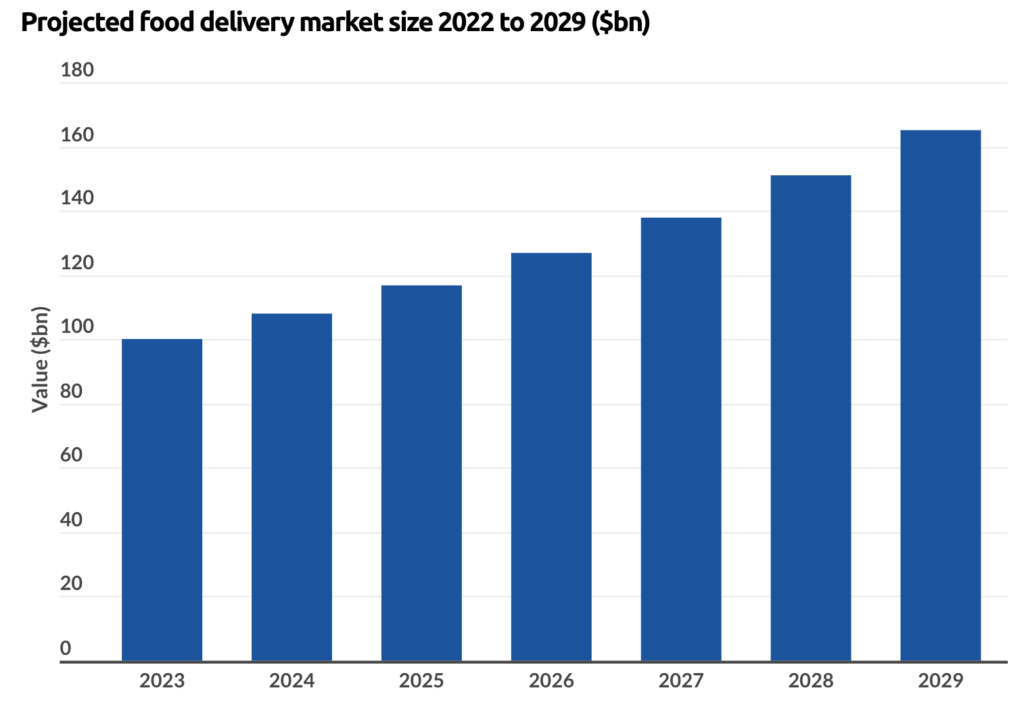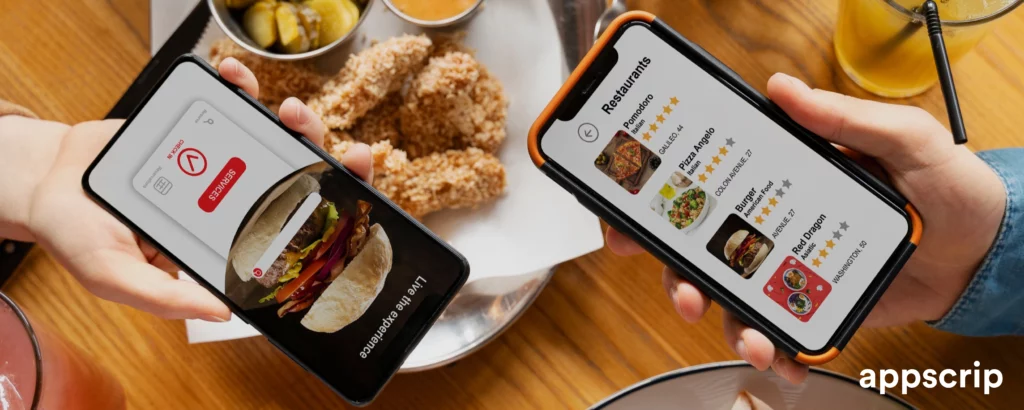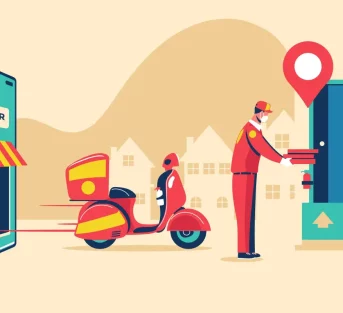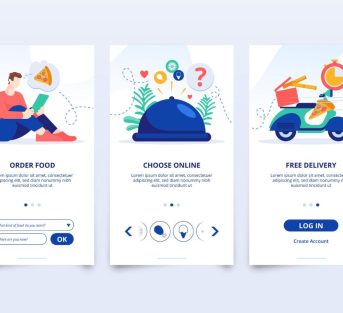Food delivery isn’t just a convenience anymore in NYC—it’s a way of life. Whether you’re ordering dinner after a long day, stocking up for a get-together, or just avoiding the cold, apps make it way too easy to get anything you’re craving right to your doorstep.
Here’s how big it’s gotten: in 2024, DoorDash and Uber Eats together owned more than 70% of the NYC food delivery market. Grubhub held on to around 22%. Delivery workers in the city earned an average of $22.48 an hour in Q2, which is more than double what they made just a year before. Nationwide, food delivery is expected to rake in over $429 billion by 2025, and almost 7 out of 10 Americans ordered food online last month.
So if you live in the city, odds are you’re using one of these platforms regularly. But which ones really stand out? That’s what this list is for. We’re breaking down 10 of the most used (and most useful) top food delivery apps in NY—from household names to niche picks that deserve more love.
Let’s get into it.
TL;DR
- NYC’s food delivery market is massive, with Uber Eats and DoorDash holding over 70% of the local share and industry revenue expected to reach $429B by 2025.
- We analyzed 10 top delivery apps including Grubhub, Uber Eats, DoorDash, Seamless, Caviar, ChowNow, Delivery.com, Goldbelly, Gopuff, and FreshDirect—each with unique features, business models, and lessons for startups.
- Key trends include subscription models (like DashPass), hyperlocal loyalty (Seamless), premium dining (Caviar), multi-category delivery (Delivery.com), and fast warehouse logistics (Gopuff).
- Each app breakdown includes: features, founders, funding, revenue models, and actionable startup takeaways.
- Appscrip offers a ready-to-launch food delivery platform with scalable tech, custom branding, and built-in features like tracking, payments, and driver management.

Top Food Delivery Apps In NY
This is an era where the world is grappling with different variants of the virus followed by traffic jams. It is high time that we think of embracing the best alternatives without stepping outside our homes for basic necessities.
Online food ordering is one such initiative that has been achieved through food delivery platforms. This initiative will also contribute to lessening our carbon-foot-print.
Thus, let us explore the top food delivery apps in NY to make our life easy and hassle-free:
Grubhub
Grubhub is one of the oldest food delivery apps and a staple in NYC’s delivery ecosystem. Launched in 2004, it set the standard for digital ordering long before food delivery became the norm. It continues to hold a solid market share due to its massive restaurant network, ease of use, and deep-rooted brand familiarity. Grubhub is especially known for offering 24/7 service, which fits well with New Yorkers’ unpredictable schedules. Its focus on transparent delivery timing and real-time tracking keeps it relevant in an increasingly competitive space.
- Features: 24/7 delivery access, real-time tracking, advanced filtering (by cuisine, speed, price), Grubhub+ membership, scheduled orders, group ordering.
- Business Model: Charges restaurants commissions and customers service/delivery fees; offers a paid subscription tier (Grubhub+).
- Funding: Raised $84M before IPO; acquired by Wonder in 2024.
- Founders: Matt Maloney and Mike Evans.
- Why it works: Built strong early restaurant partnerships and retained users with a straightforward, reliable experience.
- Startup lesson: Nail down restaurant onboarding early. A strong supply side is the backbone of any food delivery app.
Uber Eats
Uber Eats is one of the most recognized food delivery platforms in NYC and beyond. Its expansion was supercharged by leveraging Uber’s established rideshare infrastructure, which allowed it to scale delivery logistics quickly without starting from scratch. Today, it stands out for its clean app interface, consistent performance, and tight integration with both customers and delivery partners. Its AI-powered recommendations and time estimates help make ordering feel personal and fast, while group order features and contactless delivery options keep it flexible.
- Features: Real-time ETA tracking, AI-driven delivery time predictions, group orders, scheduled deliveries, personalized restaurant recommendations, and contactless delivery.
- Business Model: Earns revenue from restaurant commissions, delivery fees, and in-app restaurant advertising.
- Funding: Launched under Uber, which raised over $25 billion before its IPO.
- Founders: Travis Kalanick and Garrett Camp.
- Why it works: Uber Eats combines sophisticated logistics with a clean user experience, making ordering smooth for users and scalable for restaurants.
- Startup lesson: If you have infrastructure advantages, use them. And if not, invest early in route optimization and backend logistics.
DoorDash
DoorDash dominates the U.S. market and holds a major chunk of NYC’s food delivery traffic. Its rise was driven by a focus on smaller suburban markets first before expanding into big cities like New York. DoorDash is known for being user-friendly, quick, and dependable. Its DashPass subscription service gives users fee-free delivery from select restaurants, boosting retention and recurring revenue. It also provides robust POS integration, making it easier for restaurants to manage orders and inventory.
- Features: DashPass membership, real-time order tracking, smart substitutions, easy scheduling, contactless delivery, and seamless restaurant POS integration.
- Business Model: Mix of commissions from restaurants, subscriptions (DashPass), white-label logistics (Drive), and advertising.
- Funding: Raised $2.5 billion before IPO in 2020.
- Founders: Tony Xu, Stanley Tang, Andy Fang, Evan Moore.
- Why it works: Combines speed and reliability with tech that benefits both users and merchants.
- Startup lesson: Offer layered revenue streams like subscriptions and logistics-as-a-service to grow sustainably.
Seamless
Seamless has deep NYC roots and built its initial success by catering to busy professionals who wanted quick and simple food ordering, especially for office lunches. Even though it’s now merged with Grubhub, it still enjoys a strong brand presence among locals. Its appeal lies in its consistent performance, easy navigation, and loyal customer base built over years of reliable service.
- Features: Corporate meal planning, repeat ordering, easy-to-use interface, pre-order scheduling, and loyalty features.
- Business Model: Commission-based earnings and delivery/service charges.
- Funding: Raised $50 million before merging with Grubhub.
- Founder: Jason Finger.
- Why it works: Seamless combines simplicity and trust—two things that keep busy urban users coming back.
- Startup lesson: Familiarity and regional loyalty matter. A focused local strategy can outplay national campaigns.
Caviar
Caviar made its mark by going after a specific slice of the market: people who want delivery from upscale restaurants that don’t usually offer it. While it’s now owned by DoorDash, it still maintains a premium feel and curated approach that sets it apart. The app focuses on giving users a refined experience, from UI to restaurant partners. That means fewer but better choices, upfront pricing, and restaurants that users can’t always find on mainstream delivery apps.
- Features: Curated list of high-end restaurants, advance ordering, clear delivery fee breakdowns, exclusive dining partners, and high-quality presentation.
- Business Model: Takes a larger commission but targets higher-ticket orders; caters to restaurants that value exclusivity and better margins.
- Funding: Initially acquired by Square, then sold to DoorDash.
- Founder: Jason Wang.
- Why it works: Caviar offers a luxury experience without the fuss. It appeals to an audience that wants restaurant-quality food without leaving home.
- Startup lesson: If you can deliver on quality, people will pay more. Don’t be afraid to go premium.
ChowNow
ChowNow takes a different route from most food delivery platforms. Instead of competing on logistics, it empowers local restaurants to create their own branded ordering experience. This B2B focus means ChowNow avoids charging commissions and instead makes money through software subscriptions. Restaurants love the model because they keep more of their earnings and retain customer data—a big win in a delivery-heavy market.
- Features: White-labeled apps and websites, loyalty tools, built-in marketing support, and integrations with restaurant POS systems.
- Business Model: SaaS subscription; restaurants pay a monthly fee instead of commission.
- Funding: Raised over $60M by 2022.
- Founder: Christopher Webb.
- Why it works: Independent restaurants want autonomy, and ChowNow gives them tools to compete with third-party giants.
- Startup lesson: Not every model has to be marketplace-based. Building the right tools can be just as powerful as being the middleman.
Delivery.com
Delivery.com built its identity around being the all-purpose delivery platform. It doesn’t just do food—it brings groceries, alcohol, laundry, and more straight to your door. For NYC residents juggling errands and long workdays, having one app for multiple needs is a game-changer. Instead of focusing on just one category, Delivery.com casts a wide net and positions itself as the all-in-one convenience hub.
- Features: Multi-category support (food, alcohol, laundry, groceries), recurring delivery scheduling, tipping options, and order bundling.
- Business Model: Takes commissions and service fees per vertical.
- Funding: Raised $10 million in early-stage rounds.
- Founder: Jed Kleckner.
- Why it works: Its value comes from convenience and coverage—it eliminates the need for multiple apps.
- Startup lesson: Deliver more than just food. Versatility can drive frequency and build long-term loyalty.
Goldbelly
Goldbelly redefined what food delivery means by focusing not on local convenience but on national gourmet experiences. Instead of delivering from the nearest restaurant, Goldbelly ships iconic meals from legendary spots across the U.S.—think deep-dish pizza from Chicago, lobster rolls from Maine, or cheesecake straight from New York. It turns food into a giftable, shippable product for customers who want an experience, not just a quick bite.
- Features: Nationwide shipping, curated collections (by chef, holiday, region), premium packaging, gifting options, subscription boxes.
- Business Model: Takes a commission from vendors and adds margins on packaging and shipping.
- Funding: Raised $133 million as of 2021.
- Founder: Joe Ariel.
- Why it works: Goldbelly taps into food nostalgia and storytelling—people aren’t just buying a meal, they’re buying an experience.
- Startup lesson: Delivery doesn’t always have to be fast. If you can make it memorable, it’s worth the wait.
Gopuff
Gopuff runs on a different model from most delivery apps—it owns its inventory and fulfills orders from micro-warehouses across major cities. This lets it promise ultra-fast delivery (under 30 minutes in most cases) for everyday essentials like snacks, beverages, toiletries, and more. It’s not just a food app—it’s a digital convenience store that fits in your pocket.
- Features: 24/7 delivery in many cities, live stock tracking, category browsing (snacks, cleaning, pet care, etc.), 30-minute average delivery time, optional subscription (Gopuff Fam).
- Business Model: Revenue comes from direct product sales, delivery fees, and membership subscriptions.
- Funding: Raised over $3.4 billion.
- Founders: Yakir Gola and Rafael Ilishayev.
- Why it works: With inventory under its control, Gopuff delivers faster and more predictably than marketplace-based apps.
- Startup lesson: Owning the entire stack—from inventory to delivery—can unlock better margins and brand consistency, but requires serious capital.
FreshDirect
FreshDirect has long been a household name for grocery delivery in NYC. It appeals especially to families, meal planners, and customers who care about food quality and origin. Unlike apps that focus on immediate convenience, FreshDirect lets customers schedule deliveries in advance and even customize their weekly shopping routines. Its transparency on sourcing and freshness has earned strong trust.
- Features: Scheduled delivery windows, meal kits, bulk order support, farm-to-door produce tracking, rotating seasonal items, dietary filters.
- Business Model: Direct-to-consumer grocery retail, plus service and delivery fees.
- Funding: Raised over $280 million before being acquired by Ahold Delhaize.
- Founders: Joseph Fedele and Jason Ackerman.
- Why it works: For users who prefer planning and quality over speed, FreshDirect offers unmatched consistency.
- Startup lesson: Sometimes, reliability is the killer feature. Especially in grocery, timing and trust beat urgency.
NYC’s food delivery space is saturated—but it’s also full of signals for entrepreneurs. From premium niches to multi-category delivery models, each app on this list carved out a space by solving for speed, quality, convenience, or loyalty.
Here’s why building with Appscrip gives you an edge:
If you’re thinking about launching your own food delivery app, don’t reinvent the wheel. Go with a proven, scalable foundation that gives you the flexibility to make it your own.
- Faster Go-to-Market: Our pre-built solutions cut development time drastically so you can launch, test, and grow without delays.
- Custom Branding & UX: Get a completely branded experience, including custom user and driver apps, admin panel, and dashboards.
- Built-in Essentials: Features like real-time tracking, payment integration, push notifications, and delivery management come ready to use.
- Scalable Infrastructure: Whether you’re starting in one neighborhood or multiple cities, our tech supports growth without performance issues.
- Modular Add-ons: From loyalty programs to multiple delivery zones or scheduled orders, add features as you grow.
- Ongoing Support: We don’t just hand over the code—we support you post-launch with updates and maintenance.
So if you’ve got the vision, we’ve got the stack to bring it to life.
Explore our food delivery app development solution and book a free consultation. Let’s build your food delivery platform faster, smarter, and tailored to your market.





